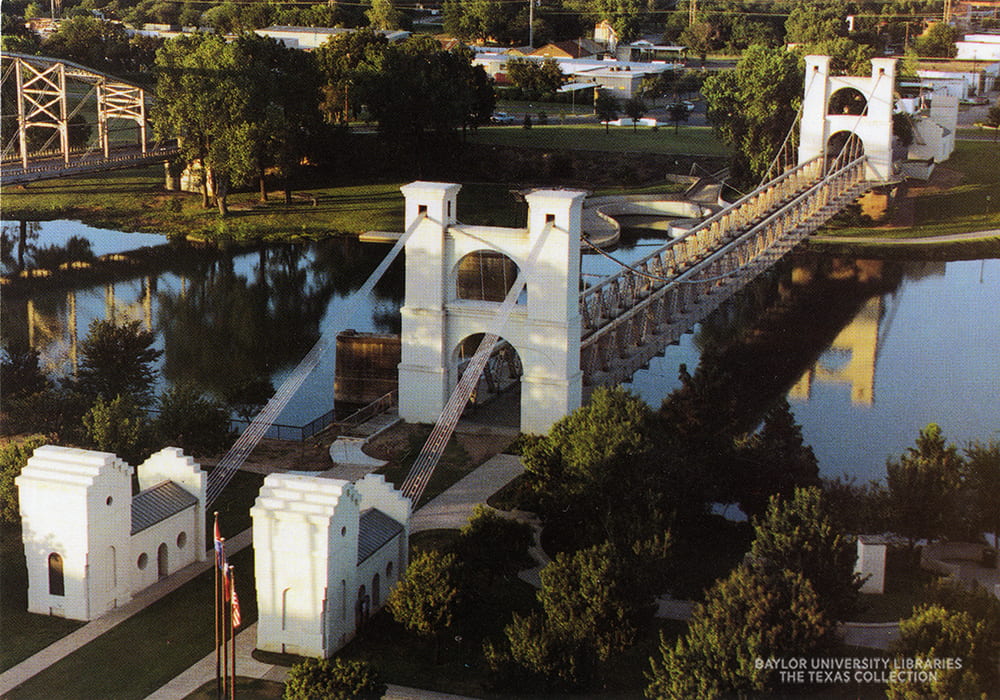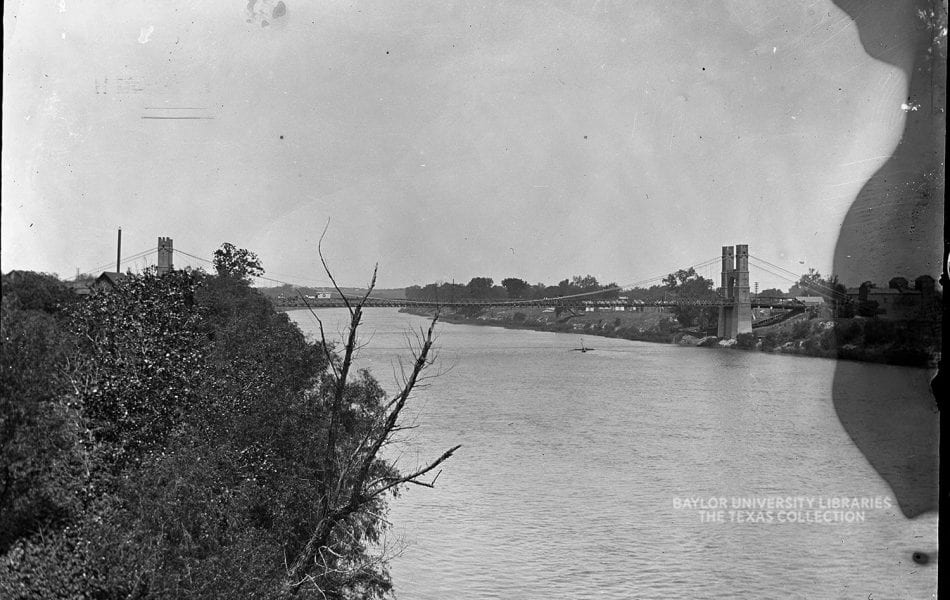By Geoff Hunt, Audio and Visual Curator, The Texas Collection, Baylor University.
Texas has changed quite a bit over the years, as is readily seen in our vast photograph and postcard collections. To help bring some of those changes to life, we’ve created a “Texas over Time” blog series that will illustrate the construction and renovations of buildings, street scenes, and more. Our collections are especially strong on Waco and Baylor images, but look for some views beyond the Heart of Texas, too.
A Victorian Era Waco Suspension Bridge photo from about 1900, General Photo Files, The Texas Collection; 2019 photo of same location by G.H. Today, the addition of 25 bronze cattle sculptures pay homage to Waco’s past and its role in the cattle drives of the 19th- century. The placement of the longhorn and cattle sculptures throughout the 2010’s is also part of Waco’s “Branding the Brazos” effort. The sculptures also include African American, white, and Hispanic cowboys managing the herds.
Waco Suspension Bridge:
The Waco Suspension Bridge officially turns 150 years old in January 2020. It was operated by the Waco Bridge Company and officially opened to traffic in January of 1870. Its construction began in 1868, and was done at a cost of about $140,000; this equals to about $2.6 million today when adjusted for inflation. With toll fees of about 2 1/2 to 10 cents for each pedestrian, animal with rider, or cattle per head, the bridge quickly paid for itself. At that time, it was the only bridge across the Brazos River and there was nothing like it west of the Mississippi River. Its location was strategic near the route of the old Chisholm Trail, and after all these years, the 475-foot bridge is still one of Waco’s most recognizable landmarks.
At the time of its completion, Roger N. Conger later wrote, “It was at that time the longest single span suspension bridge the world had ever seen.” The cables and steelwork were supplied by the John Roebling Company. Roebling was a famed civil engineer who aided in the design of the Brooklyn Bridge as well as his namesake’s John A. Roebling Suspension Bridge in Cincinnati. As the only bridge over the Brazos River in its early days, Waco’s Suspension Bridge brought much prominence, commerce, and publicity to the city. Having already proven profitable to its builders, it became a toll free thoroughfare by 1889. In July 1970, it became the first Waco landmark on the National Register of Historic Sites. In the early 2020’s, it is scheduled to undergo its first major restoration in well over 100 years.
In 1976, the bridge received a Texas Historical Marker from the Texas Historical Commission. On the marker is the following: “In 1866 the Waco Bridge Company was granted a 25 year charter to build a toll bridge here. The charter guaranteed that no other bridge or ferry could be built within five miles. Construction began in 1868, and after much financial difficulty, was finished in 1870. Bridge traffic included wagons, pedestrians, and cattle herds. Special rates were given to heavy users. From 1875 to 1889 the public agitated for a free bridge, but the company retained its monopoly. Then, in 1889, the bridge was sold to McLennan County which gave it to the city of Waco as a free bridge.”
In 1910-1914, the bridge underwent significant structural and cosmetic changes. This included a new cable system and a roadway supported with steel. The towers were remodeled and reinforced, and stucco applied, altering the cosmetic appearance of the bridge from the original design. Bridge photo from about 1900, General Photo Files, The Texas Collection; 2019 photo from same location by G.H.
Waco Suspension Bridge, circa 1895, taken from the West bank of Brazos River with East side to the right; metaslider shows same image with high-resolution zoom of East side of bridge. Gildersleeve-Conger collection (4×5 inch glass plate negative), The Texas Collection.



Sources:
Conger, Roger N., “Highlights of Waco History,” Waco, Tx, 1945.”
Waco Bridge Company records, The Texas Collection, Baylor University.






No Comments